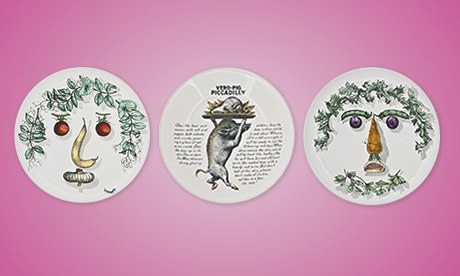
Like most people, I wish I was rich, and perhaps never more so than when browsing a Christie's catalogue for an auction called The Art of Food and Drink. So many things I long to own! But alas, I am broke. By the time you read this, then, I will definitely not be in possession of an English 1920s fitted picnic hamper complete with a kettle on a spirit burner stand (the estimate was £2,000-£3,000), nor, alas, of a French wrought-iron and brass boulangerie rack dating from 1900 (with scrolled decorative mounts and a matching baguette trolley, this was a likely snip, again at £2,000-£3,000). I will also have passed on a set of seven Victorian copper jelly moulds (£2,500-£3,000), and on a butcher's shop display that includes an iron steelyard with a brass weight and three carved wooden hams (£800-£1,200). Most vexing of all, someone else will be the proud new owner of four Piero Fornasetti "whimsical recipe" ceramic plates made for the Fleming Joffe Company in the 1970s (£800-£1,200). This is too bad: I did so love the look of the one featuring "iguana and chicken breasts".
Granted, this catalogue, with its emphasis on provenance and authenticity, is terribly grand, and the estimated prices in it quite loopy. Nevertheless, it's no surprise that there should be such a thriving market for ancient kitchen utensils and ephemera. It's the same at both ends of the market; just try buying an old bread bin on eBay if you don't believe me (you will bid … and bid … and bid). The days, it seems, when a prized wedding dinner set and a much-loved canteen of bone-handled cutlery were passed from generation to generation are now pretty much at an end, and this has left our kitchens – the room where, in the 21st century, many people now spend most of their time – without a soul. Our Habitat plates, John Lewis dishes and Ikea glasses do the job just fine, but they hardly add to the pleasure of the ritual of cooking, serving or eating. They are functional items, pure and simple, and when they smash or chip or turn cloudy, as they will sooner rather than later, we send them to the dump without so much as a second thought.
I'm a part of this new greediness for secondhand kitchen equipment, though happily, I did inherit a few things; I'm lucky in the sense that I had working-class grandparents, who looked after special belongings, and parents who were both only children and part of the upwardly mobile 70s generation that lusted after old stuff, the better to spruce up the falling-down Victorian houses they'd bought.
Thanks to my grandmothers, I have a good set of Sheffield plate cutlery, to be used on special occasions (it is not dishwasher proof); a lovely, delicate tea set in yellow and gold (ditto); and four large meat plates, mottled with use (I use them for cheese). Other stuff, I've collected: eight sail-sized linen napkins embroidered with my initial which I bought at a vintage fair; a 1950s lemonade jug and six matching candy-coloured glasses found in a junk shop in Lewes; a lucky eBay bread knife with a carved wooden handle that says: "Manners makyth man" (it's blunt, but this seems not really to matter). A couple of things were presents. The loveliest of these is a set of silver implements for eating lobster – Edwardian, I think – that a very dear friend gave me on Christmas Day 2012. Just looking at them makes you want to rush to the fishmonger, and sod the cost.
I like a big, white, gleaming dinner plate as much as the next person: even fried eggs and baked beans look elegant on such a backdrop if you get the kitchen roll out. But I can't relate to homes where all the glasses and mugs match, and where nothing comes with a story attached. To me, this is cold and unwelcoming, like sitting down at a dining table without candles.
One of the reasons I like the Quality Chop House in Clerkenwell so much is because all its china and glassware is old and mismatched. This feels so much more hospitable than a dinner service that has arrived on a lorry straight from a catering wholesaler – and it speaks to the times, too, for this is supposed to be the era both of recycling, and of ethics in the kitchen. A pig that has led a happy life is a very fine thing, but even better if it doesn't then arrive on a plate that was made in a factory in China.

